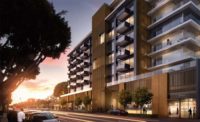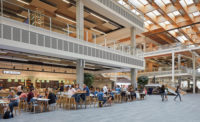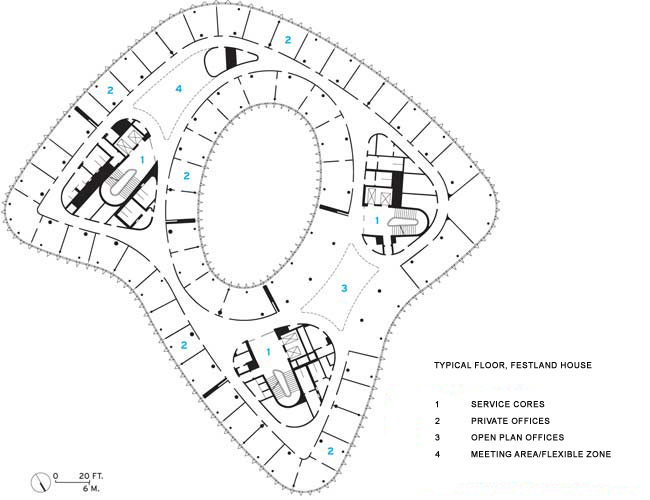Oval Offices
The free-form shapes and autumn-colored louvers of two sibling office buildings are studies in contrast to the surrounding business district, proving that chart-topping efficiency can be sleek and comfortable, too.














Architects & Firms
Cologne, Germany
The German-born American painter Josef Albers saw color as pivotal in differentiating between 'optical and physical perception' on canvas. In three-dimensional architecture, color also changes mood, alters perception, and liberates or reduces volume. The Berlin-based firm Sauerbruch Hutton, founded in 1989, has used color intuitively in all of its projects, from the 1999 expansion and renovation of the GSW Headquarters in Berlin to the prizewinning Brandhorst Museum in Munich, completed in 2008. Early on, principals Matthias Sauerbruch and Louisa Hutton realized that simple and relatively inexpensive applications of color could help transcend the confines of the site. And they discovered that 'color families,' which they often refer to, could be used as another design tool. The Oval Offices in Cologne are no exception to their portfolio.
The offices — two distinct, amoeba-shaped buildings — sit on four acres of parklike land beside the Rhine River and are wrapped in 5,000 red and green glass louvers. The six-story Festland House and the seven-story Ufer House complement the surrounding leafy landscape. The louvers appear to subtly change color depending on their angle and the weather. Over the last 20 years Cologne’s business district has developed outward from the city center around its Gothic cathedral to form a string of unspectacular business headquarters along both banks of the Rhine. The Oval Offices are a contrast here, in aesthetics and energy conservation.
The project is the first in Cologne to earn an EU GreenBuilding certificate, one of the initiatives of the European Commission’s 2004 GreenBuilding Programme, which aims to encourage owners of nonresidential buildings to specify more energy-efficient technologies. Hutton says this success is partly due to a particularly supportive client, Munich Ergo AssetManagement, and an open-minded project manager, Burkhard Klother. It also made economic sense. The real estate market in Cologne is highly competitive and green building is an important selling point. The buildings are designed to consume approximately 31,700 BTUs per square foot per year of primary energy, which is less than half the power used in many of the conventional, neighboring air-conditioned offices.
This is largely achievable due to passive climate-control systems. The heating and cooling system pumps Rhine River water, with an average temperature of 61 degrees, through a heat exchanger, which, in turn, regulates water temperature in a closed pipe system embedded in the floor slabs. Rainwater from the site is directly channeled back into the river, shortcutting the usual route through the city’s often overloaded drainage and wastewater treatment system.
The facades are made up of full-height windows and fixed panels of insulated, double-glazed units. Occupants can open windows for ventilation and vertical, finlike glass louvers provide shade. (They are computer-operated but can be manually overridden by control panels in each office.) Roof gardens on both buildings insulate the structure and boost the microclimate’s oxygen supply, in addition to offering bird’s-eye views of the river and city.
The 463,000 gross square feet of flexible space accommodates a total of 1,700 workstations. At press time the project team was completing final punch-list items at Ufer, and Festland was fully occupied. The offices all have access to two of the three vertical circulation cores. Reinforced concrete columns rise from a 242-car underground garage, divided between the two buildings, to support the roof, while smaller circumference columns act as hangers for the suspended floor plates. This configuration makes for open layouts and uninterrupted views to the surrounding landscape.
Ceiling treatments help define programmatic zones. A circulation spine that runs through the daylight-filled workspaces has a dropped ceiling. Cloudlike suspended ceiling “fingers” of hand-molded plaster and resin branch out from the spine and hover over the workstations. Each finger conceals lighting, mechanical ventilation, and a sprinkler system.
Technical and practical features are translated into unique art objects, like the bull’s-eye lighting fixtures, touch screen technology hidden behind colored glass walls in the elevators and elevator lobbies, and unobtrusive wall-mounted glass tablets in offices for climate and security control. All details complement the buildings’ undulate exterior, which makes every office space unique.
The project has achieved a high level of environmental efficiency. Ultimately, however, it is the attention to form, detail, color, and space that makes the Oval Offices so successful.
Location: Cologne, Germany
Completion Date: June 2010
Gross square footage: 463,000 sq.ft.
Construction cost: $116 million
People
Owner
Architect:
Personnel in architect's firm who should receive special credit: Jens Ludloff, Claudia Sieper, Wilhelm Jouaux, Jürgen Bartenschlag, Tom Geister, Angelika Fehn-Krestas, Markus Pfeifer, Frank Anaker, Stefan Fuhlrott, Stephanie Heese, Tanja Kausch-Löchelt, Lina Lahiri, Claus Mannsbrügge, Konrad Opitz, Peter Rieder, Maria Saffer
Engineer(s)
HVAC:
Consultant(s)
Lighting:
Acoustical:
Energy concept:
Project management:
Photographer(s)
© Constantin Meyer
CAD system, project management, or other software used: |
Products
Structural system
Manufacturer of any structural components unique to this project:
Exterior cladding
Other cladding unique to this project:
Roofing
Elastomeric:
Bitumen
Windows
Glazing
Skylights:
Other:
Doors
Wood doors:
Fire-control doors, security grilles:
Revolving doors
Hardware
Interior finishes
Cabinetwork and custom woodwork:
Paints and stains:
Paneling:
Floor and wall tile (used in all toilets):
Carpet:
Special interior finishes unique to this project:
Furnishings
Lighting
Downlights:
Exterior:
Inteligentenvironmental control:
Conveyance |











